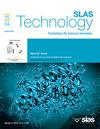The RoboSeed facilitates automated extraction of cereal mature embryos
IF 3.7
4区 医学
Q3 BIOCHEMICAL RESEARCH METHODS
引用次数: 0
Abstract
To overcome a critical bottleneck in plant biotechnology workflows, a semiautomated system RoboSeed was developed to extract mature embryos from cereal grains such as barley. In contrast to the commonly used manual extraction, the robot employs a precision-controlled pressing rod which applies mechanical force along an optimal trajectory and angle to detach intact embryos. A custom image-processing pipeline determines grain orientation and morphology, enabling precise rod alignment at the optimal force application point. Validation experiments using two barley cultivars (Noga and Golden Promise) and soaking duration of 10 and 20 h revealed optimal force application point relative location in the range 0.5–0.6, achieving maximum extraction success rates of 56.2 % (Noga) and 36 % (GP) after 20 h soaking. RoboSeed operated with a median cycle time of 20.9 s per extraction, translating to 37.2 s per successful embryo, compared to 27.9 s with expert manual extraction. While current throughput is lower than conventional methods, RoboSeed offers significant advantages in consistency, reduced reliance on operator skill, and potential for scaling. Future improvements include full automation of grain singulation, robotic arms for post-extraction handling, and expanded testing across additional genotypes. RoboSeed’s modular design provides a robust foundation for scalable, high-throughput embryo extraction, with potential to accelerate cereal transformation, gene mapping studies, and tissue culture-based research.
RoboSeed有助于谷物成熟胚胎的自动提取。
为了克服植物生物技术工作流程中的一个关键瓶颈,开发了一种半自动系统RoboSeed,用于从谷物(如大麦)中提取成熟胚胎。与常用的人工提取不同,该机器人采用精密控制的压杆,沿着最佳的轨迹和角度施加机械力来分离完整的胚胎。定制的图像处理管道确定晶粒方向和形态,从而在最佳施力点实现精确的杆对齐。以Noga和Golden Promise两种大麦品种为研究对象,浸泡时间分别为10和20 h,结果表明,最佳施力点相对位置在0.5 ~ 0.6范围内,浸泡20 h后提取成功率分别为56.2% (Noga)和36% (GP)。RoboSeed每次提取的平均周期时间为20.9秒,每个成功胚胎的平均周期时间为37.2秒,而专家人工提取的平均周期时间为27.9秒。虽然目前的吞吐量低于传统方法,但RoboSeed在一致性,减少对操作人员技能的依赖以及扩展潜力方面具有显着优势。未来的改进包括谷物模拟的全自动、提取后处理的机械臂,以及对其他基因型的扩展测试。RoboSeed的模块化设计为可扩展、高通量的胚胎提取提供了坚实的基础,具有加速谷物转化、基因定位研究和组织培养研究的潜力。
本文章由计算机程序翻译,如有差异,请以英文原文为准。
求助全文
约1分钟内获得全文
求助全文
来源期刊

SLAS Technology
Computer Science-Computer Science Applications
CiteScore
6.30
自引率
7.40%
发文量
47
审稿时长
106 days
期刊介绍:
SLAS Technology emphasizes scientific and technical advances that enable and improve life sciences research and development; drug-delivery; diagnostics; biomedical and molecular imaging; and personalized and precision medicine. This includes high-throughput and other laboratory automation technologies; micro/nanotechnologies; analytical, separation and quantitative techniques; synthetic chemistry and biology; informatics (data analysis, statistics, bio, genomic and chemoinformatics); and more.
 求助内容:
求助内容: 应助结果提醒方式:
应助结果提醒方式:


